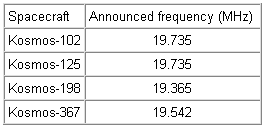 Certain
types of Soviet satellites for which TASS published short-wave
frequencies
were never picked up by space listeners in the West (1).
Now, with detailed knowledge into Soviet space history, these old
mysteries
may be worth revisiting.
Certain
types of Soviet satellites for which TASS published short-wave
frequencies
were never picked up by space listeners in the West (1).
Now, with detailed knowledge into Soviet space history, these old
mysteries
may be worth revisiting.
 Certain
types of Soviet satellites for which TASS published short-wave
frequencies
were never picked up by space listeners in the West (1).
Now, with detailed knowledge into Soviet space history, these old
mysteries
may be worth revisiting.
Certain
types of Soviet satellites for which TASS published short-wave
frequencies
were never picked up by space listeners in the West (1).
Now, with detailed knowledge into Soviet space history, these old
mysteries
may be worth revisiting.
| Spacecraft |
|
| PROTON 1 |
|
| PROTON 2 |
|
| PROTON 3 |
|
| PROTON 4 |
|
 Kosmos-102
was a prototype RORSAT (Radar Ocean Reconnaissance Satellite - a
Western designation for this spacecraft called US-A in Russian (5))
hardware using chemical batteries in place of the nuclear reactor to
feed
the radar subsystem. Launched from Baikonur 28 December 1965 using a
11A510
launch vehicle. (identified by Igor Lissov as the 11A510, possibly a
two-stage
version of the standard 11A511 Soyuz booster. Kosmos-125 was
also
a prototype RORSAT hardware using chemical batteries in place of
nuclear
reactor. Launched from Baikonur 20 July 1966 again using a 11A510
launch
vehicle. Lost on the 52nd revolution as a result of a possible failure
in the chemical power units placed on board instead of the nuclear
BES-5
(4).
The third RORSAT, Kosmos-198, launched on 27 December 1967 on a
Tsyklon launch vehicle, was the first satellite in the series to be
boosted
to a 900 km storage orbit, but according to Rudenko (4)
did not yet carry the BES-5 nuclear power generator. Kosmos-367
was launched by a Tsyklon-2 rocket from Baikonur at 1033 UT on 3
october
1970 and was boosted into a 915-1022 km orbit at 65.3 degrees
inclination
after having operated in a 250-270 km orbit.
Kosmos-102
was a prototype RORSAT (Radar Ocean Reconnaissance Satellite - a
Western designation for this spacecraft called US-A in Russian (5))
hardware using chemical batteries in place of the nuclear reactor to
feed
the radar subsystem. Launched from Baikonur 28 December 1965 using a
11A510
launch vehicle. (identified by Igor Lissov as the 11A510, possibly a
two-stage
version of the standard 11A511 Soyuz booster. Kosmos-125 was
also
a prototype RORSAT hardware using chemical batteries in place of
nuclear
reactor. Launched from Baikonur 20 July 1966 again using a 11A510
launch
vehicle. Lost on the 52nd revolution as a result of a possible failure
in the chemical power units placed on board instead of the nuclear
BES-5
(4).
The third RORSAT, Kosmos-198, launched on 27 December 1967 on a
Tsyklon launch vehicle, was the first satellite in the series to be
boosted
to a 900 km storage orbit, but according to Rudenko (4)
did not yet carry the BES-5 nuclear power generator. Kosmos-367
was launched by a Tsyklon-2 rocket from Baikonur at 1033 UT on 3
october
1970 and was boosted into a 915-1022 km orbit at 65.3 degrees
inclination
after having operated in a 250-270 km orbit.
Explanation?
The announced frequencies of these craft are given in the table above. The first two frequencies are the same as those announced for the failed Venus probe Kosmos-96 (see below), the third the same as for the Luna failure Kosmos-111 (see below). The frequency for Kosmos-367 (19.542 MHz) is the same frequency that was used throughout the remainder of the RORSAT series and from which signals were received on many occasions by myself and other members of the Kettering group. The first signals on this frequency (19.542 MHz) received by myself was Kosmos-723 in April 1975. Observations of many RORSAT missions showed that the short-wave signals were very rare during the low-orbit phase of the mission, but much more frequent in the high-orbit, "storage" phase of the flight. Perhaps the HF beacon was used to monitor the status of the reactor. The fact that the HF transmitter was rarely active in the low-orbit phase may have contributed to the fact that we did not find signals from the Kosmos satellites in the table.
 These
two spacecraft were reported by TASS to have been using the frequencies
listed in the table on the right. The fascinating thing about these two
launches is that they both involved attempts at escaping Earth orbit
and
that the Kosmos label was a cover for a Venus and lunar probe failure
respectively.
These
two spacecraft were reported by TASS to have been using the frequencies
listed in the table on the right. The fascinating thing about these two
launches is that they both involved attempts at escaping Earth orbit
and
that the Kosmos label was a cover for a Venus and lunar probe failure
respectively.
Kosmos-96 was launched from Baikonur with a Molniya 8K78M launch vehicle at 0321 UT on November 23, 1965. The payload was a 3MV-4 Venus probe weighing about 960 kg. The last stage and the probe entered a 222-296 km orbit at 51.9 degrees inclination. What happened was that at T+528 sec, during the final thrust phase of the Block I's 8D715K engine, one of the combustion chambers blew up due to a tear in the fuel pipeline. This resulted in an abnormal separation of the upper stages. The escape stage Block L entered parking orbit tumbling and was not able to operate properly.
Kosmos-111 was launched from Baikonur with a Molniya 8K78M launch vehicle at 1102 UT on March 1, 1966. The payload was a Ye-6S lunar orbiter (similar to Luna 10) weighing about 1597 kg. The last stage and the probe entered a 168-180 km orbit at 51.8 degrees inclination. The escape stage Block L lost roll control during unpowered coast in parking orbit because the axis of the course regulator of the control system jammed in the zero position. The stage's engine was not fired.
Explanation?
So, why were short-wave
frequencies
announced for these vehicles? Did the Blok-L carry a short-wave
transmitter(s)
to be able to monitor the progress of the flight during the first 80-90
minutes in parking orbit before the escape trajectory burn without
stationing
ships around the whole first orbit? If that is so, then the transmitter
could only be expected to be switched on during about 90 minutes
following
launch - nothing more. The chances of picking up these signals would
therefore
have been slim in the extreme! Following the the launch of Kosmos-146
short-wave signals (20.008 MHz) were picked up for more than a
week.
This happened even after the Blok-D stage of this 7K-L1 (Zond) test
flight
had fired to put the vehicle in an elliptical orbit 24 hours after
launch.
Was there a short-wave transmitter in one of the fragments left in low
earth orbit? Did this transmitter have the same role as the announced
transmitters
of Kosmos-96 and -111 might have had, i.e. to monitor the functioning
of
attitude control and ignition subsystem of the escape stage?